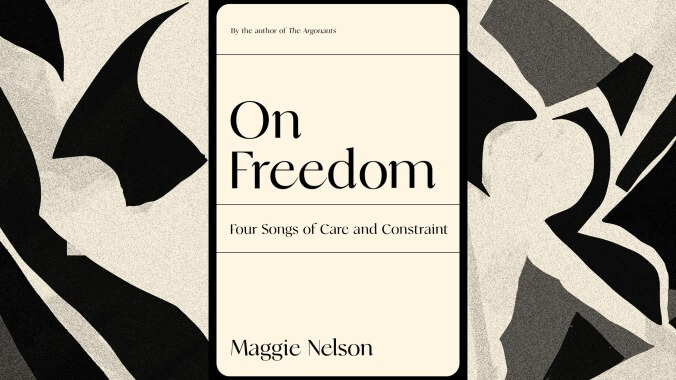Maggie Nelson is sometimes called a collagist, for her nonfiction that seemingly defies classification in its combining of memoir, literary analysis, and reportage. “Hybrid” is another word people use. (They really get hung up on those unindented paragraphs that float out on their own like square islands.) In On Freedom: Four Songs Of Care And Constraint, Nelson positions herself as cousin to a collagist: a synthesizer. She draws significantly from theorists like Eve Kosofsky Sedgwick, Fred Moten, and David Graeber, before carving out her own thoughts around the sticky notion of freedom. In the book’s best passages, her patient buildup in defining others’ concepts leads to some full, complex insights; in its weaker sections, Nelson hops from idea to idea or gets mired in the heady theory.
Nelson knows what “freedom” conjures, including the right wing’s appropriation of it and other language of social uprisings, but wants to wrestle back the “depleted, imprecise, [and] weaponized” word and give life to a more generous and useful definition. With this work, the writer isn’t presenting solutions to “unfreedom” within sex, art, drugs, and climate—the focus of the four “songs” of the book’s title. She instead hopes to “bear down on the felt complexities of the freedom drive in four distinct realms… wherein the coexistence of freedom, care, and constraint seems… particularly thorny and acute.” (In addition to being a writer of poetry and nonfiction, Nelson is an academic, and phrasing like “bear down on the felt complexities” is indicative of the prose throughout On Freedom.)
As in her other nonfiction works, like the bestselling The Argonauts, here Nelson resists the binary, showing how diminishing and impractical it is to divide thinking into absolutes. How individuals act with regards to climate change, for example, is often framed as either doing whatever one wants, no matter the effect on the environment, or resolutely committing to protecting the Earth and future generations. The unfortunate result of this split is that it “risks reducing ‘obligation’ to moral hectoring, and ‘freedom’ to a cheap, self-serving hedonism.” Deleterious consequences and a general stuckness arise from such black-and-whites, with nowhere to go in these conversations as long as their current framing is accepted. It’s easy to fall on one side of another either/or of our climate future—being “fucked” or “not fucked”—but Nelson notes that only an approach somewhere between the two will lead to the kind of action that might actually abate global warming.
She similarly works to break open a binary found in the art world and the culture at large: the harm and repair model of restorative justice. Nelson uses as case studies two semi-recent controversies: Dana Schutz’s painting of Emmett Till in his coffin, Open Casket, which appeared in the Whitney Biennial in 2017, and Sam Durant’s Scaffold, a life-size sculpture of gallows installed outside the Walker Art Center in Minneapolis the same year. Nelson is less interested in whether these white artists should have created and displayed works that re-present violence against Black and Indigenous peoples (though she all but says they should have); she’s more intrigued by what happens when a work of art is deemed harmful and its removal is demanded as a form of redress. Nelson tends to avoid buzzwords like “cancel culture,” but here she works harder to identify the phenomenon’s animating forces than those who might use the term without quotation marks, arguing that, at this point, it’s disingenuous to say that something like cancel culture doesn’t exist.
The section on sex, titled “The Ballad Of Sexual Optimism,” also stands out. There, punchier and firmer declarations emerge; the first-person says hello. When Nelson recounts the apology that Evan Stephens Hall, frontman of the band Pinegrove, made in 2017 over his sexual encounters with female fans, her exasperation overtakes the academic tone: “If I hit on a guy after being super turned on by his charismatic performance and he responded, ‘Sorry, I know you think you want this, but due to the implicit power I hold over you because of my celebrity and gender privilege, it’s simply not possible for you to know what you want,’ I would be livid.” Nelson argues that, for all its gains, #MeToo has also had the effect of reducing men and women to predators and potential victims, with women’s sexual desire all but erased. It’s as though by more broadly acknowledging the power differences between, say, a male boss and a female employee, the culture has allowed those dynamics to become obliterative and total. Though it takes a while for her to get there, Nelson is staking claims within ongoing debates in these passages. The sections where she addresses drugs and climate change, by contrast, come across more as lays of the land, not unlike college survey courses (to wit, “Drug Fugue” is largely taken up by feminist readings of notable drug literature).
Despite what the book’s cloying title might suggest, Nelson pulls back on a certain breathy muchness that can appear in her writing. One hallmark of her style that remains—and is turned up to the nth degree—is her tendency to equivocate. The lyrical clarity found in her cult favorite Bluets is here replaced with clauses tacked on clauses, paragraph-length parentheticals, and long em-dashed interruptions. The frequent amendments and caveats occasionally work to her benefit, in that they delineate exactly what she’s saying and nothing more; but other times, they have the effect of Nelson muscling into a crevice so small that one questions the benefit of fitting inside it. Across Nelson’s work, there’s the sense of her swinging the pendulum from one end of the discourse to the murky middle; here, for better and worse, it feels like she’s dragging it.
Author photo: Harry Dodge












![HBO teases new Euphoria, Larry David, and much more in 2026 sizzle reel [Updated]](https://img.pastemagazine.com/wp-content/avuploads/2025/12/12100344/MixCollage-12-Dec-2025-09-56-AM-9137.jpg)




























